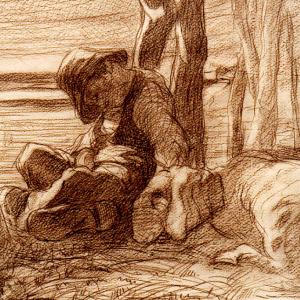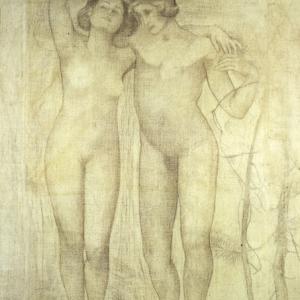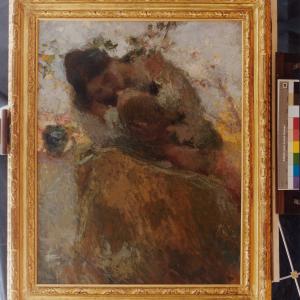From the hall where Miss Bell is exhibited, one is attracted, on the right, by the famous Testa dell'Alpe by Leonardo Bistolfi: a genuine visual objective that leads the visitor into the space dedicated to symbolism. The protagonists, in addition to Bistolfi, are Giovanni Segantini and Giuseppe Mentessi. Bistolfi, the Italian sculptor who was most conscious of and attentive to the proposals of a new international symbolist feeling, is represented there with six sculptures, very significant for understanding his artistic path and also the collection methods of the Frugone. The six works, in fact, give an account of the collecting criteria that animated the Frugone brothers and their dealer Stefani and summarize Bistolfi's cultural references, documenting his adherence to the demands of realism, with Per i campi (or Pastorella) and Il terzetto, sapid anecdotes of peasant daily life dated to around the first half of the eighteen eighties.
Mater dolorosa is linked to the symbolist poetics, a bronze modelled sensitive to light, perhaps purchased by Ferruccio Stefani at the Venetian Biennale in 1905 and sold to G. B. Lazzaro Frugone in 1920; and the Testa dell'Alpe, subject repeatedly replicated by the sculptor. The two last works of the Piedmontese artist, L’offerta (or La luce) and Il profumo, are small and refined marbles derived from large chalk models and sketches, conserved at the Gipsoteca of Casale Monferrato, inspired to a classical-style plasticism, with déco intonations in the floral decorations. They were designed around 1917 as decorative elements of a fountain inspired by the "spirits" of the garden, that is "the light, the perfume, the voices".
Giovanni Segantini (Arco, Trento 1858 -Schafberg 1899) is represented in the room by a large and unusual unfinished charcoal canvas, Gli amanti. The symbolism of Giuseppe Mentessi (Ferrara 1857-Milan 1931) is documented by a reworking of the central compartment of the “Gloria” triptych, exhibited at the 1901 Venetian Biennale (Rome, National Gallery of Modern Art), dedicated to L’amore materno, which the artist renders with a crushed, frothy brushstroke still close to the style of Lombard Scapigliatura.







